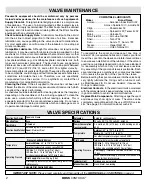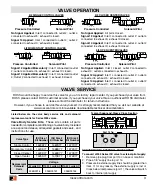
Pneumatic equipment should be maintained only by persons
trained and experienced in the maintenance of such equipment.
Supply Clean Air.
Foreign material lodging in valves is a major cause
of breakdowns. The use of a 5-micron-rated air filter located close to
the valve is strongly recommended. The filter bowl should be drained
regularly, and if its location makes draining difficult, the filter should be
equipped with an automatic drain.
Check Lubricator Supply Rate.
A lubricator should put a fine oil mist
into the air line in direct proportion to the rate of air flow. Excessive
lubrication can cause puddling in the valve and lead to malfunctions.
For most applications an oil flow rate in the lubricator of one drop per
minute is adequate.
Compatible Lubricants.
Although this valve does not require air line
lubrication, it may be used with lubricated air being supplied to other
mechanisms. Some oils contain additives that can harm seals or other
valve components and so cause the valve to malfunction. Avoid oils with
phosphate additives (e.g., zinc dithiophosphate), and diester oils; both
types can harm valve components. The best oils to use are generally
petroleum base oils with oxidation inhibitors, an aniline point between
180°F (82°C) and 220°F (104°C), and an ISO 32 or lighter viscosity.
Some compatible oils are listed at the right. These oils, although believed
to be compatible, could change without notice because manufacturers
sometimes reformulate their oils. Therefore, use oils specifically
compounded for air line service. If it is a synthetic oil, contact the oil
manufacturer for compatibility information.
Cleaning the Valve.
If the air supplied to the valve has not been well
filtered, the interior of the valve may accumulate dirt and varnish which
can affect the valve’s performance.
A schedule should be established for cleaning all valves, the frequency
depending on the cleanliness of the air being supplied. To clean the
valve use a solvent which will dry without leaving a residue. This is
especially important for the spool-and-sleeve assembly. Do not use a
chlorinated solvent or abrasive materials which can damage seals or
do permanent damage to metal parts.
2
ROSS
CONTROLS
®
VALVE SPECIFICATIONS
VALVE MAINTENANCE
COMPATIBLE LUBRICANTS
Maker
Brand Name
Amoco ......................American Industrial Oil 32
Amoco Spindle Oil C, Amolite 32
Citgo ........................Pacemaker 32
Exxon .......................Spinesstic 22, Teresstic 32
Mobil .........................Velocite 10
Non-Fluid Oil ............Air Lube 10H/NR
Shell .........................Turbo T32
Sun ...........................Sunvis 11, Sunvis 722
Texaco ......................Regal R&O 32
Union ........................Union Turbine Oil
To reassemble the spool and sleeve put one drop of
Anderol 735 (or equivalent lubricant) on each spool land.
Insert the spool into the sleeve and rotate it several times
to ensure even distribution of the lubricant. If the valve is
used in a non-lubricated application, do not use a lubricant
for reassembly which can dry out and leave a residue.
Dry assembly of the spool and sleeve is preferable. Each
spool and sleeve is a matched set, so care must be taken
not to reverse the position of the spool in the sleeve.
Before inserting the spool-and-sleeve into the valve body,
very lightly lubricate the O-rings with a lubricant such
as MobilGrease 28. Do not use Anderol; it causes the
O-rings to deteriorate.
Electrical Contacts.
In the electrical circuits associated
with the valve solenoids, keep all switches or relay contacts
in good condition to avoid solenoid malfunctions.
Replace Worn Components.
After long usage the spool
and sleeve may show signs of wear. The valve can be
completely reconditioned with the use of ROSS service
kits. See page 3 for information about such kits.
IMPORTANT NOTE:
Please read carefully and thoroughly all the
WARNINGS
and
CAUTIONS
on page 4.
Construction Design
Spool and Sleeve
Mounting Type
Base
Flow Media
Filtered air
Construction Material
Valve Body:
Bar Stock Aluminum
Spool:
Stainless Steel
Seals:
Buna-N
Pressure Controlled Valves
Temperature
Ambient/Media:
40° to 175°F (4° to 80°C)
For other temperature ranges, consult ROSS.
Operating Pressure
ISO Size 1:
30 to 150 psig (2 to 10 bar)
ISO Size 2 & 3:
15 to 150 psig (1 to 10 bar)
All sizes also available up to 232 psig (16 bar)
Pilot Supply:
Minimum 30 psig (2 bar)
Pilot supply pressure must be equal to or greater than
inlet pressure.
Solenoid Pilot Controlled Valves
Solenoids
Rated for continuous duty
Voltage
24 volts DC; 110-120 volts AC, 50/60 Hz
Power Consumption
(each solenoid)
3.5 watts on DC (at 10 bar); 6.5 VA holding on 50 or
60 Hz
Temperature
Ambient:
40° to 120°F (4 to 50°C)
Media:
40° to 175°F (4° to 80°C)
For other temperature ranges, consult ROSS.
Pilot Supply
Internal or External; Selected automatically
Operating Pressure
ISO Size 1:
30 to 150 psig (2 to 10 bar)
ISO Size 2 & 3:
15 to 150 psig (1 to 10 bar)
All sizes also available up to 232 psig (16 bar)
Pilot Supply - Internal or External:
Minimum 30 psig
(2 bar)
When external pilot supply, pressure must be equal to
or greater than inlet pressure.
Indicator Light
Included, one per solenoid
Manual Override
Flush; Metal, non-locking






















